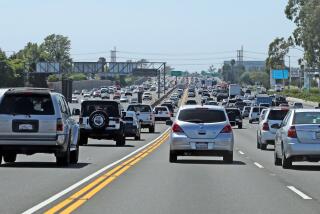Smart Highway Idea Advances, but at Only a Rush-Hour Pace
Futurists nearly half a century ago envisioned an intelligent highway system in which cars would drive themselves. Engineers at UC Berkeley are still aiming for that goal, but it remains a long way off.
By some estimates, intelligent highway systems could triple the capacity of existing highways without adding a single mile of asphalt. As traffic increases, the need for such technology is intensifying.
In the last two decades, vehicle travel increased 72%, while the U.S. road network grew just 1%. Congestion in major American cities now lasts about six hours each weekday, causing the average motorist to waste 36 hours a year in traffic jams, according to a Texas Transportation Institute study.
No crash road-building program will bail the public out of this mess. Indeed, as highway use more than doubles over the next 20 years, nobody is sure what will work. But clearly, technological improvement of the highway system is one of the few hopes.
In congressional testimony on May 10, Transportation Secretary Norman Mineta said the Bush administration proposes to increase funding for intelligent highway systems by 32% to $253 million for fiscal year 2002.
“Intelligent transportation systems and operations can make a difference in how we attack the congestion and productivity problems,” Mineta said.
Whether that is a political difference or a real one is anybody’s guess. But progress in at least some of the technologies, funded by both government and private industry, is starting to show up.
Adaptive cruise control, which automatically detects slower-moving cars ahead and reduces vehicle speed, is beginning to appear in some luxury vehicles and will show up more broadly in the years ahead.
It’s a baby step, but clearly one that demonstrates the ability of sensors to detect other vehicles and advanced software to make decisions for the driver.
The Transportation Department’s intelligent transportation system program is spreading federal dollars in every state. Since 1992, California has received $35 million, New York $80.8 million and New Jersey $91.25 million.
Among the most ambitious national efforts is the Partners for Advanced Transit and Highways, or PATH, at UC Berkeley. Most of its $6 million in annual funding comes from Caltrans rather than the federal government.
The system proposed by PATH is for a fully automated highway that envisions vehicles entering a freeway and forming into closely packed “platoons,” linked together by a communications network exchanging information about speed, highway conditions and braking.
In 1998, PATH demonstrated the ability of a group of passenger vehicles to operate free of human control along a stretch of Interstate 15 in Southern California. Its next milestone will come in 2003 when PATH attempts to demonstrate that trucks and buses also can operate autonomically.
“The emphasis is to have as much technology on the car as possible, as opposed to [embedding it in] the highway,” said J. Karl Hedrick, PATH director and an engineering professor at UC Berkeley.
A different approach is being pursued by other researchers looking into fully autonomous intelligent highway systems, in which each vehicle would operate independently, using its own on-board computing and sensors to make decisions about speed and braking.
PATH’s platoon concept, by contrast, would form up cars in tightly packed groups to maximize highway capacity.
In the 1998 experiment, eight cars were spaced about 26 feet apart and traveled at 60 miles an hour. In some cases the spacing was brought down to a mere 6 1/2 feet. Research indicates that tight platoons could reduce aerodynamic drag by 30%, improving fuel economy of each vehicle in the pack.
Platoons would be spaced far enough apart so that each group could safely stop in an emergency. Of course, there are some events that cannot be planned for and would defeat even the most intelligent of systems. For example, a refrigerator could fall off a pickup truck, Hedrick acknowledged.
Magnetic sensors in the I-15 roadbed provided vehicles in the 1998 experiment with location reference points. Such sensors are now in regular use by snowplow crews on some Sierra Nevada highways.
In the past, plow drivers used guardrails as reference points in severe winter whiteouts, dragging their plow edges along the rails. With the UC Berkeley technology, magnets embedded in the road allow the crews to stay centered by using a magnetometer. A radar system warns the crew of stalled vehicles ahead.
The platoon technology is not quite fully developed. Exactly how platoons would form up in the real world is problematic. A traffic management center would have to issue commands to each individual car seeking to join a platoon. After entering the highway, the vehicle would have to establish a communications link with a particular platoon and then merge into it.
In the 1998 experiment, the platoon already was formed before it entered the controlled section of the highway.
Still, the technology now exists.
“There are no technological showstoppers,” Hedrick said. “If somebody gave us six years to do it, we could.”
Hedrick estimates the cost of the required technology at less than $2,000 per vehicle, mainly for throttle controls, radar systems, magnetic sensors, communications systems and central processors.
If it sounds like pie in the sky, consider the U.S. air transportation system, Hedrick says. Two decades ago, the idea of commercial airliners making automated takeoffs and landings was considered absurd, but they are now commonplace.
If planes can do it, why can’t cars?
One thing still unclear is whether drivers will want to give up control of their cars on the highways.
Hedrick’s guess is that “they want it more than being [stuck] in congested traffic.”
*
Ralph Vartabedian cannot answer mail personally but responds in this column to automotive questions of general interest. Please do not telephone. Write to Your Wheels, Business Section, Los Angeles Times, 202 W. 1st St., Los Angeles, CA 90012. E-mail: ralph.vartabedian@latimes.com.







